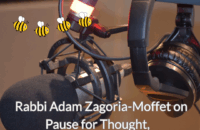Marom Trip to Madrid

This spring, 10 intrepid Maromniks ventured to Madrid. Marom (Masorti’s young adult wing) is a loose group of people at various levels of affiliation and stages of life. In addition to running numerous events in London during the year (ranging from a Chanukah poetry slam to a weekly Talmud shiur), providing a home away from home for students on campus’ across the country and publishing a journal of writing and art, Marom organises several travel opportunities.
Annually it runs Kelim, a month long volunteer or study programme at the Conservative Yeshiva in Jerusalem, and organises a shorter trip to a European destination of Jewish interest.
In the past, these have tended to be East and West European locations – Vilna, Paris and Berlin to name a few. This year, however, we challenged our Ashkenormativity and explored a very different narrative, journeying to Spain. The long weekend was a whirlwind of history, hilarity and a healthy dose of hummus.
A highlight for all of us was a day exploring beautiful Toledo, historic home of marzipan, sword-making, and one of the largest cathedrals in Europe. Toledo has an eclectic history of ‘tolerance’, which can be seen clearly in its architecture. Buildings which presented a ‘lasagne’ of history were everywhere to be seen, with churches built on mosques built on synagogues nestled in the rambling streets. Often called the ‘city of three cultures’, it was home to co-existing Jewish, Muslim and Christian communities for centuries (though our tour guide was quick to point out that these were not always peaceful). Waves of violence culminating in the Spanish Inquisition were brought home to us in a moving memorial in the garden of the Synagogue El Transito. Jewish gravestones which had been exhumed and used in construction all over Spain had been returned to rest, with a moving inscription by the Sephardi poet Ibn Ezra carved into the wall.
The hidden history of the Jews in Spain was made all the more poignant by our guide. Carmen was a PhD student who introduced herself as not Jewish (although her knowledge of Jewish practice and history put us all to shame; she had spent several years at yeshiva and could translate Hebrew and Aramaic fluently). At the end of the day, however, she revealed that her ancestors had a probable converso past. She explained that many families in Spain, hers included, practice superstitions and customs believed to have originated when the inquisition forced Jews and conversos underground. These included not wearing shoes indoors, and lighting candles on a Friday and then immediately placing them in a cupboard (a relic of the time when Jews were forced to celebrate Shabbat in secret). Carmen’s family not only did these things, but had also recently discovered a 17th century oil chanukiah in the basement of their family home; today that chanukiah rests in the Jewish museum in Toledo.
In lighter – or heavier, if we’re talking about our physiques – activity, we were treated to a culinary tour of the city, trying not just the fresh marzipan (invented by nuns there in the 12th century) but also ‘kosher’ cheese, made to a converso recipe which had been handed down in secret for hundreds of years.
Spending Shabbat with the local community was also very special; they were warm and welcoming, and it was lovely to experience a service so familiar so far from home. The experience was a gentle reminder that as European Jews we don’t always need to look to the past; our present can be just as vibrant and dynamic. Friday night was rounded off in true Noam style with an irreverent oneg, involving much mirth, singing and chocolate, and on Shabbat afternoon we covered half of Madrid by foot and played many a game of bananagrams in the Parque de El Retiro.
Following havdallah, the trip was rounded up with what Marom Madrid assured us was an authentic Spanish experience: tapas and karaoke. It was a wonderful end to a fun filled few days, where we were exposed in a thought-provoking way to the different narratives which compose the many-faceted Jewish Diapsoric experience.
Linnet Kaymer studied History at Oxford University, and is in her first year of Teach First. She grew up in the New Essex Masorti Synagogue, spent many summers as a madricha on Noam, and is also involved in Ohel Mohed, a nomadic community of young Masorti adults.




